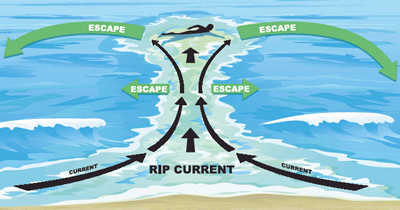Rip Currents: The Biggest Cause of Drowning

It’s lifeguard season and it’s about to be our favorite time of year…summer! We love spending our summers at the beach, enjoying the fun in the sun and getting together with friends and family. We want to make sure all our friends are safe at the beach so we wanted to share information about Rip Currents with you!
Rip currents are the biggest cause of drowning. But most people don’t actually know what they are.
Basically when a wave breaks, the water comes in to the shore. When the water has no where else to go, it all funnels into one area and that goes back out against the waves. It makes a river-like current going out towards the sea. People get caught in this current and their first instinct is to swim back to land.
When you try to swim back to shore and against this current, it is like swimming up a river. you end up getting tired and that is why it feels like you are going under. Nothing pulls you under. There is a miscommunication about an undertow. There is no such thing as an undertow.
The #1 way to get out of a rip current:
Try and relax and swim parallel to shore. Swim parallel to shore until you can reach a sandbar or you are out of the rip current and then you can swim back in.
If you have any kind of swimming ability you can get out of a rip current. Most of the time people panic and they try to swim straight back to shore and that’s where we come out and help them. And even you’ll see lifeguards when they make rescues in rip currents they swim the victim out of the rip current first and then come back to land.
Before going out in the ocean, make sure you know your limits and always check in with the lifeguard. Get more water safety tips!
-Jeff Hart, ISLA Lifeguard and LA County Lifeguard.

Learn more about How Rip Currents Form by NOAA.
